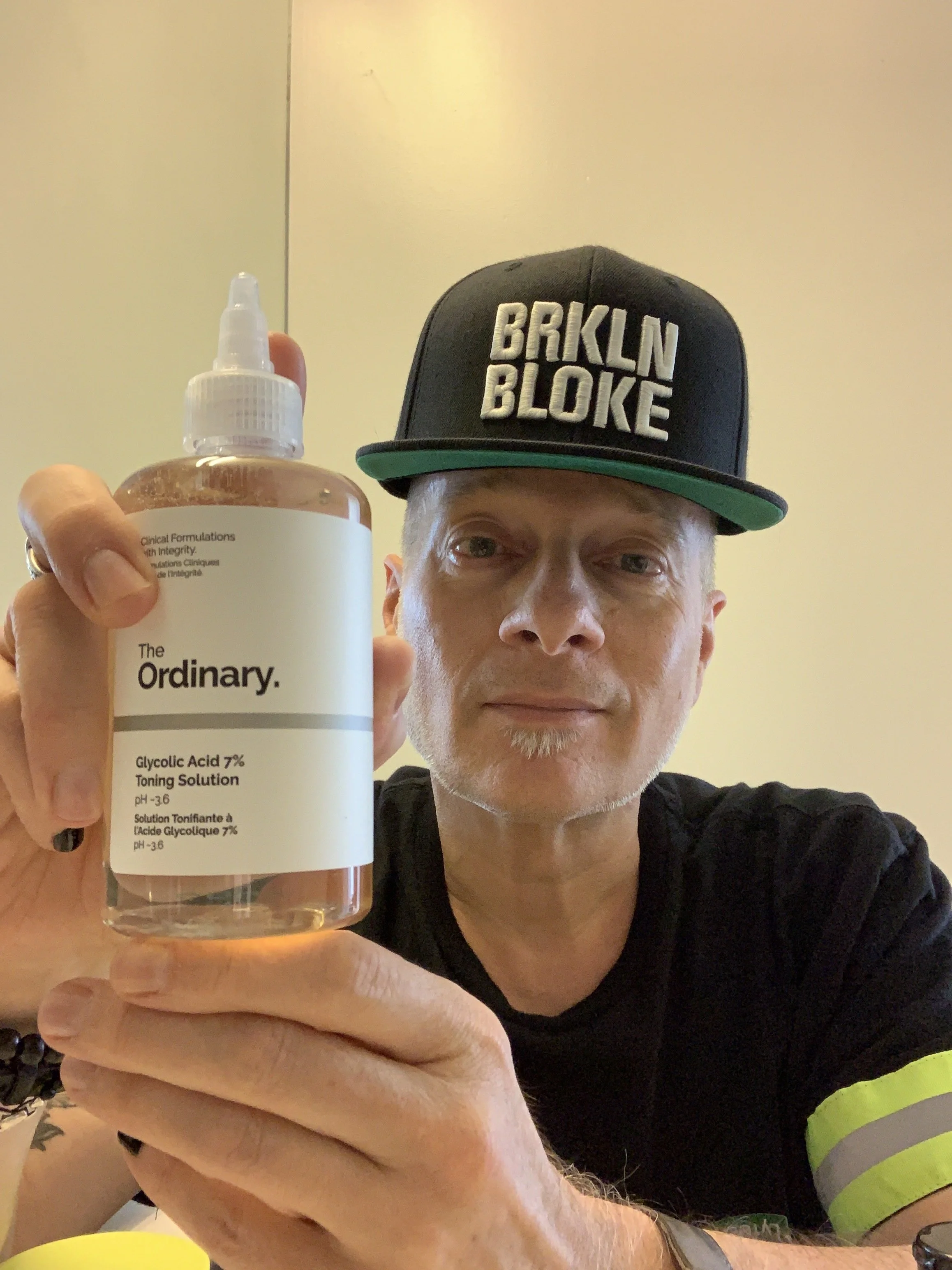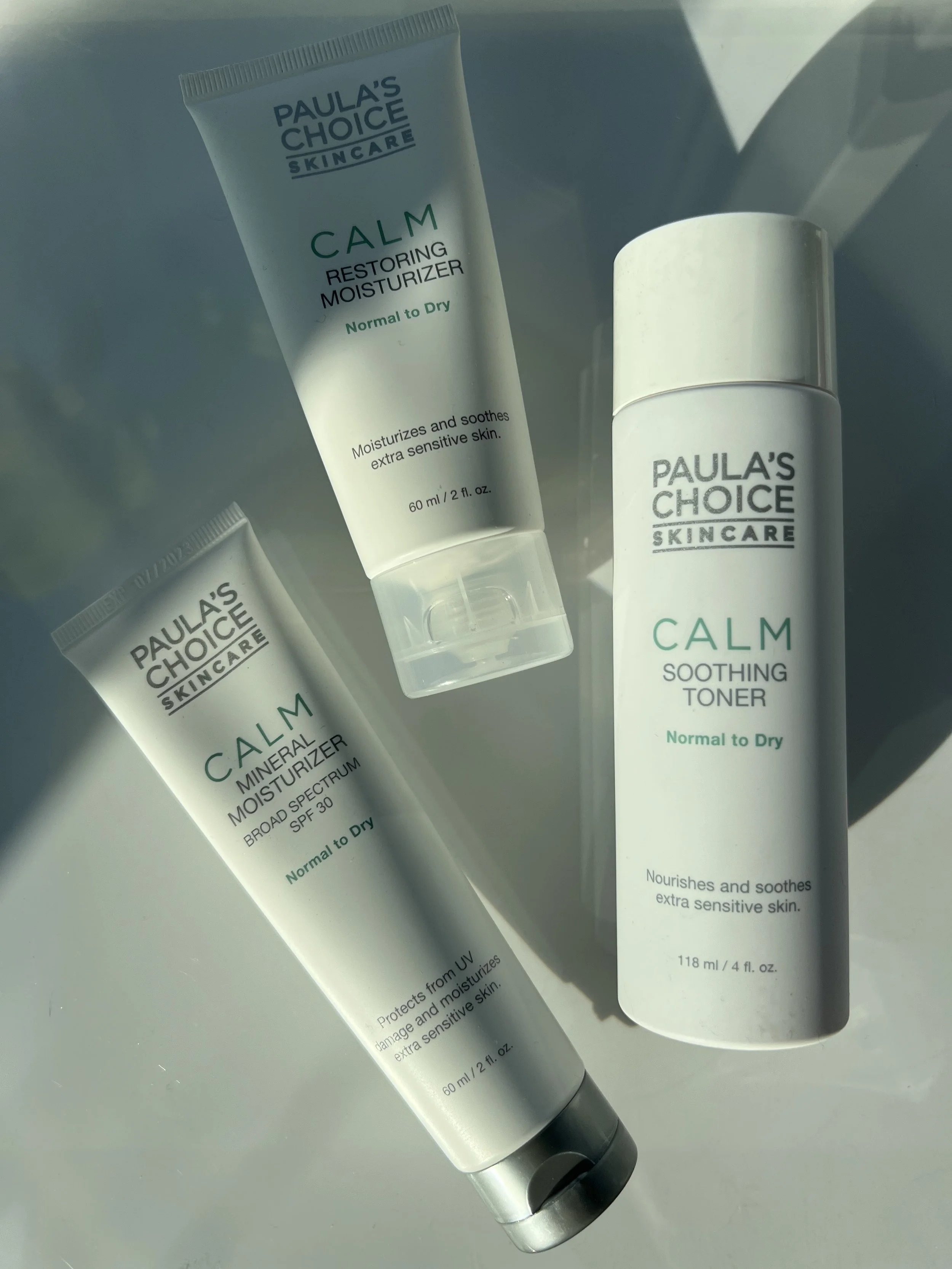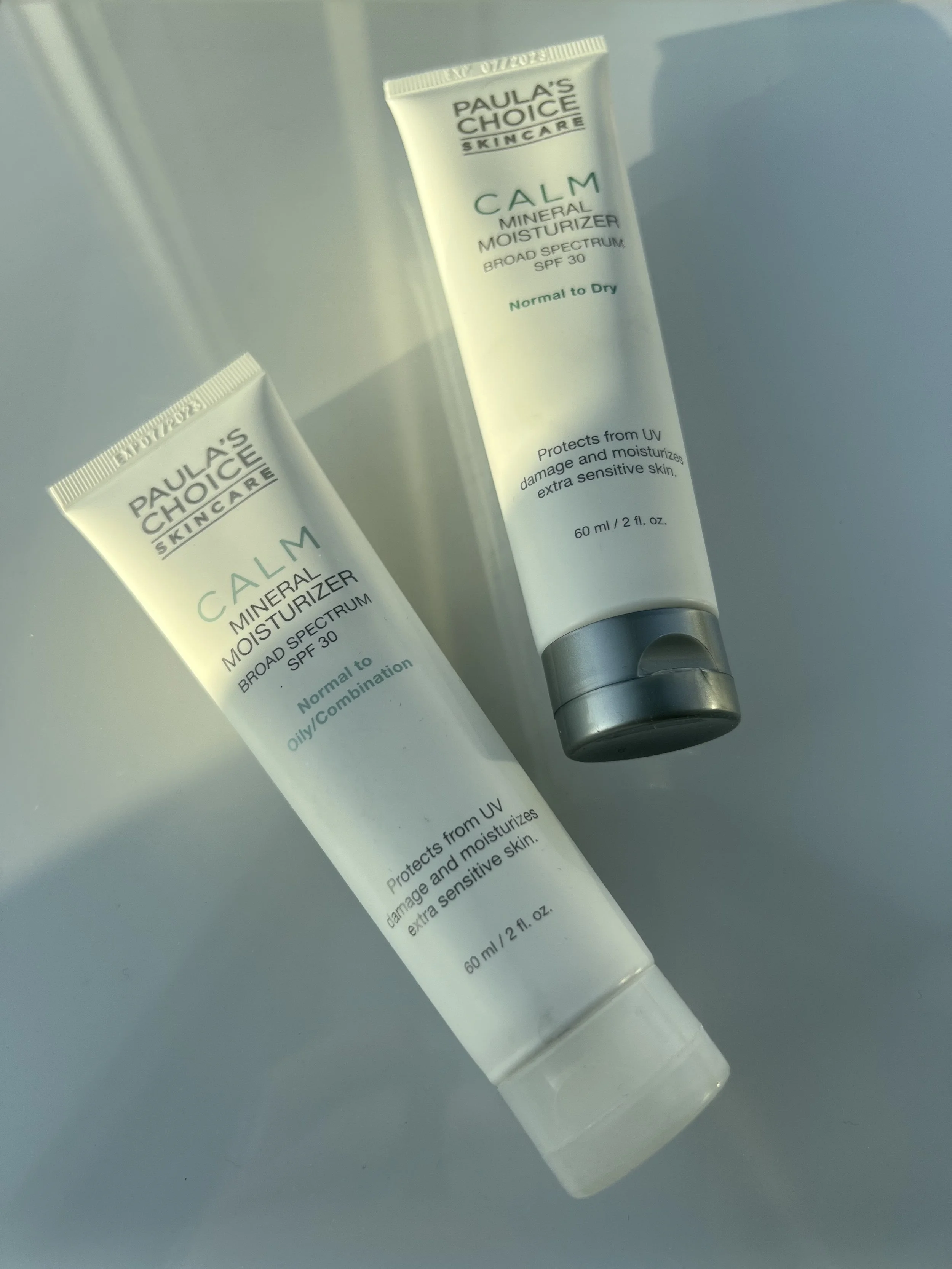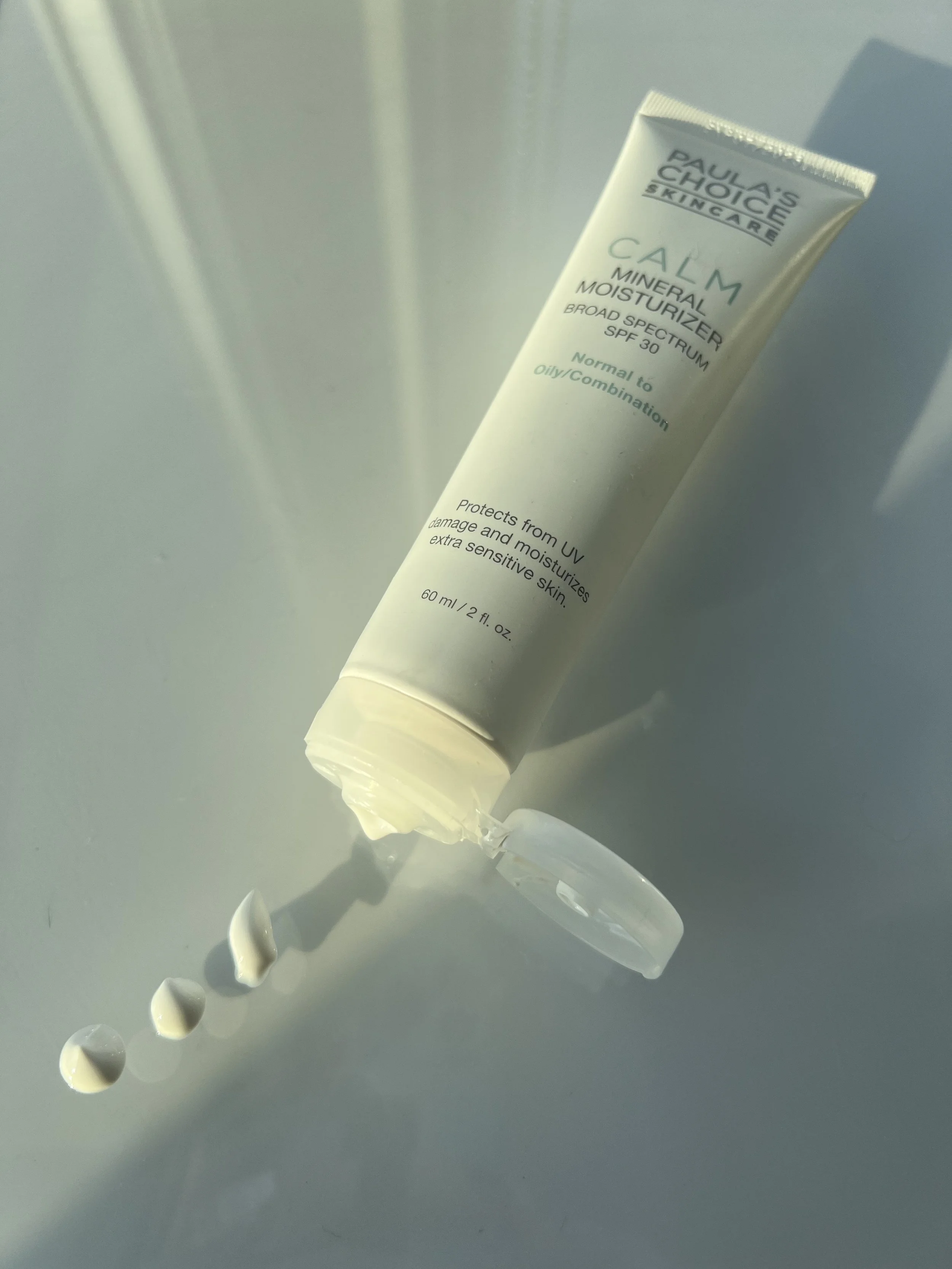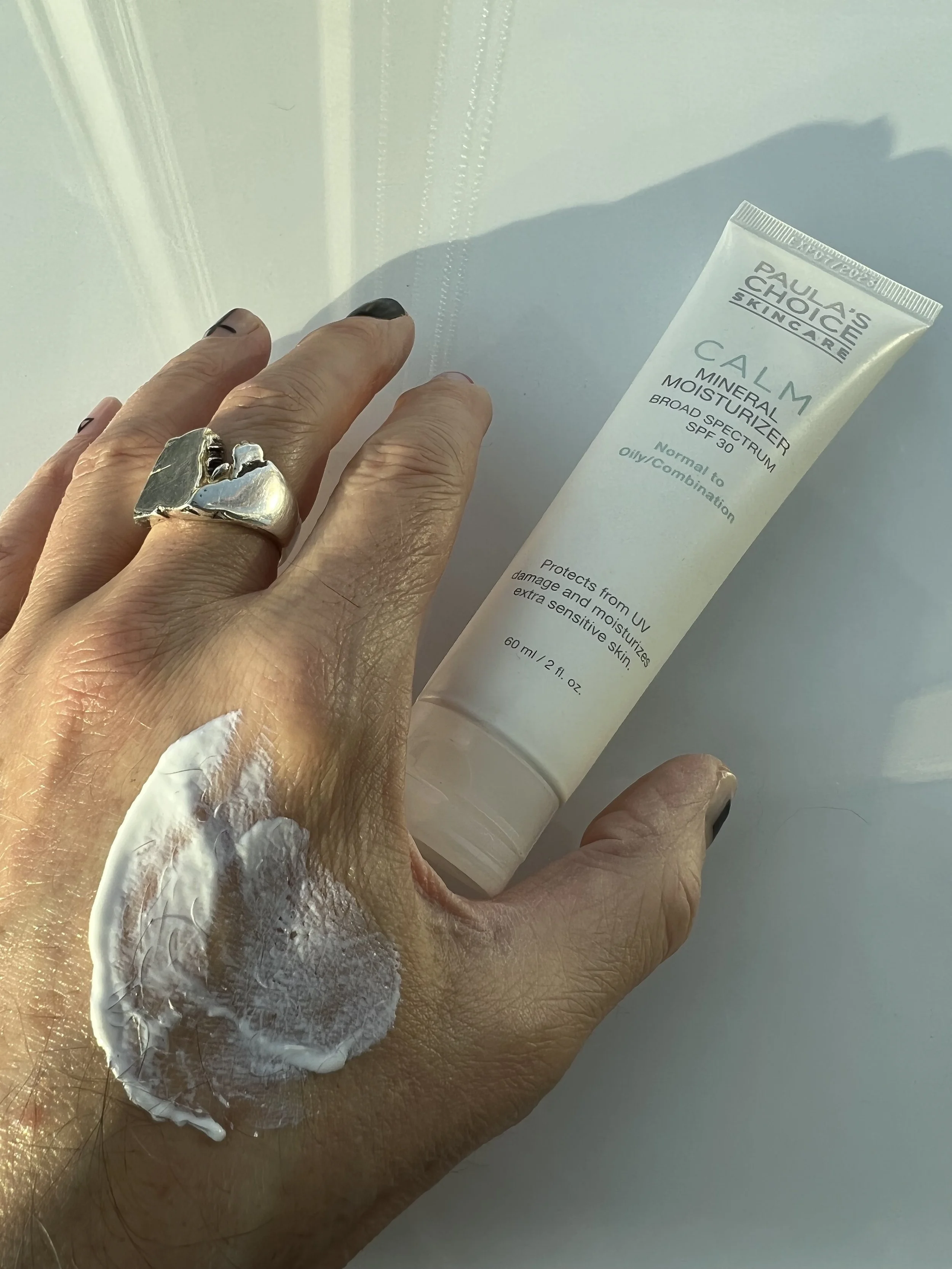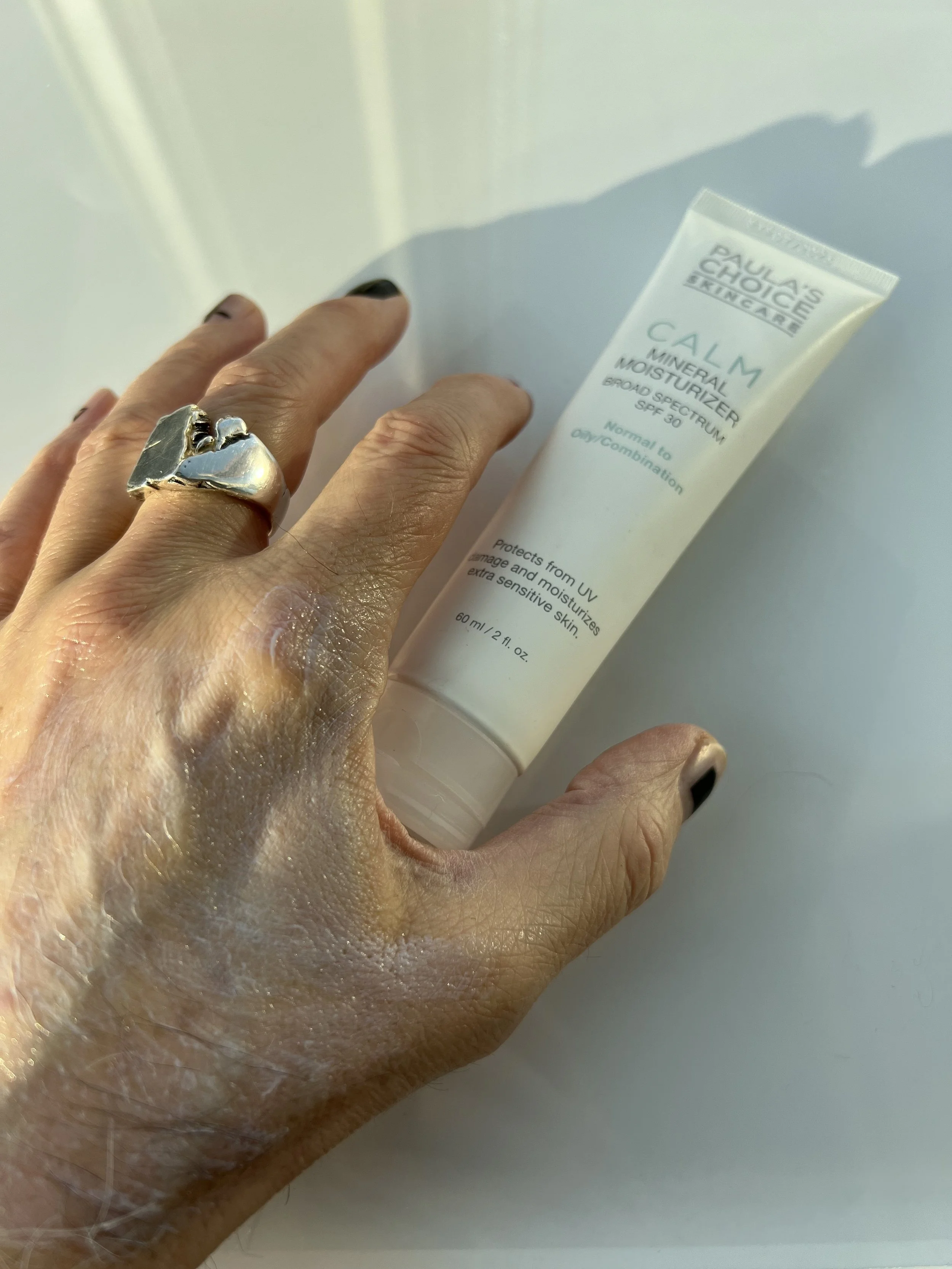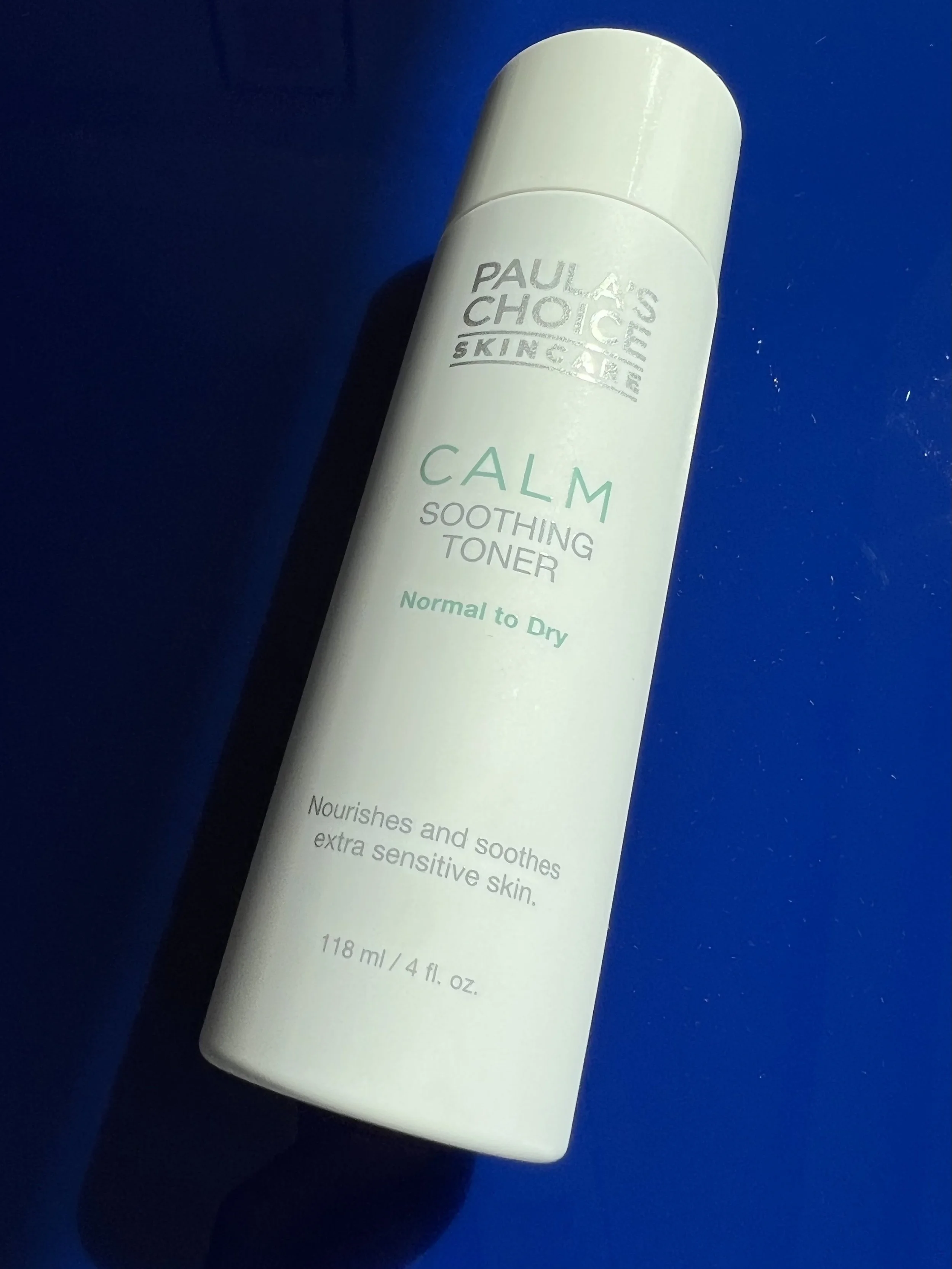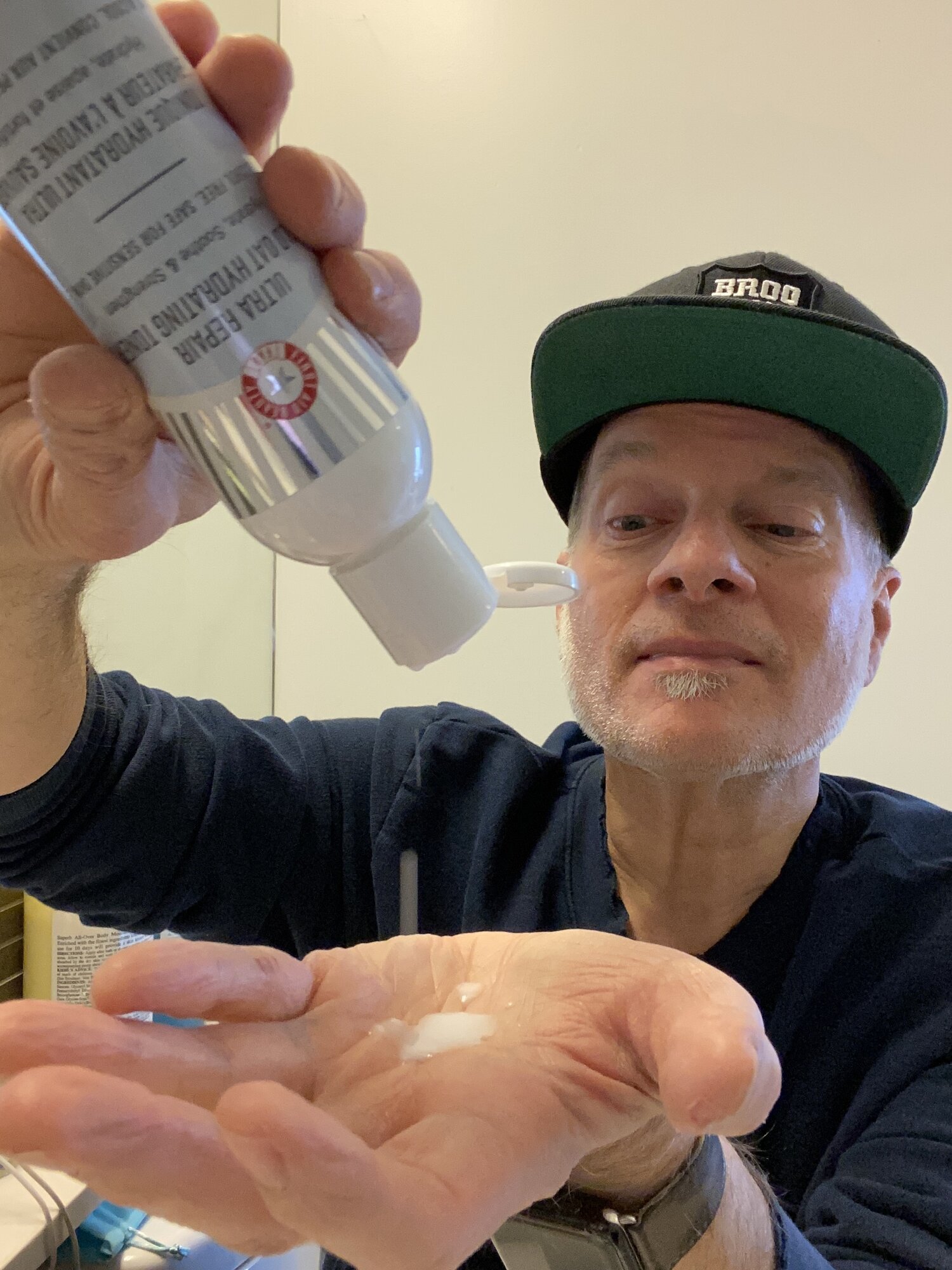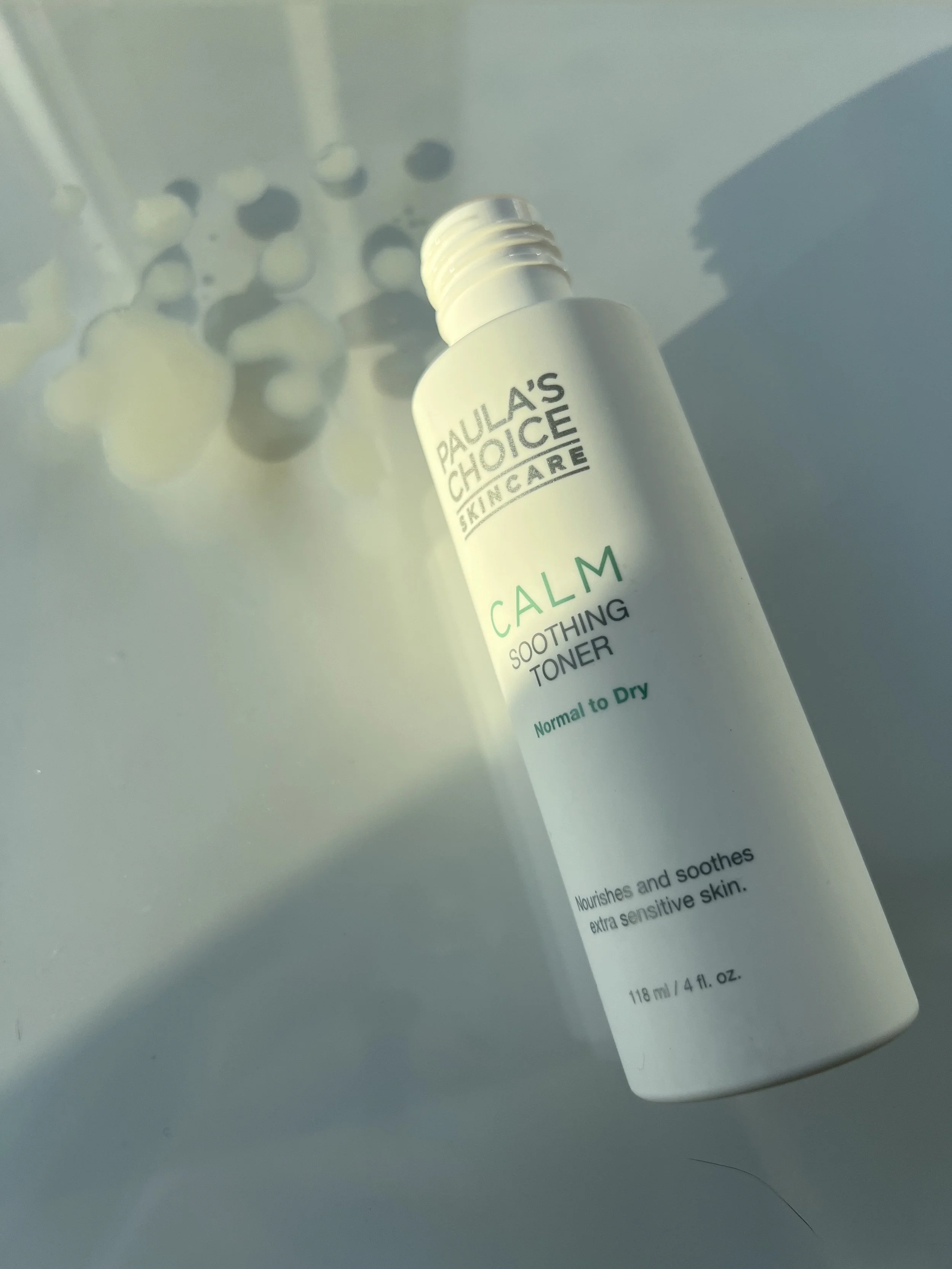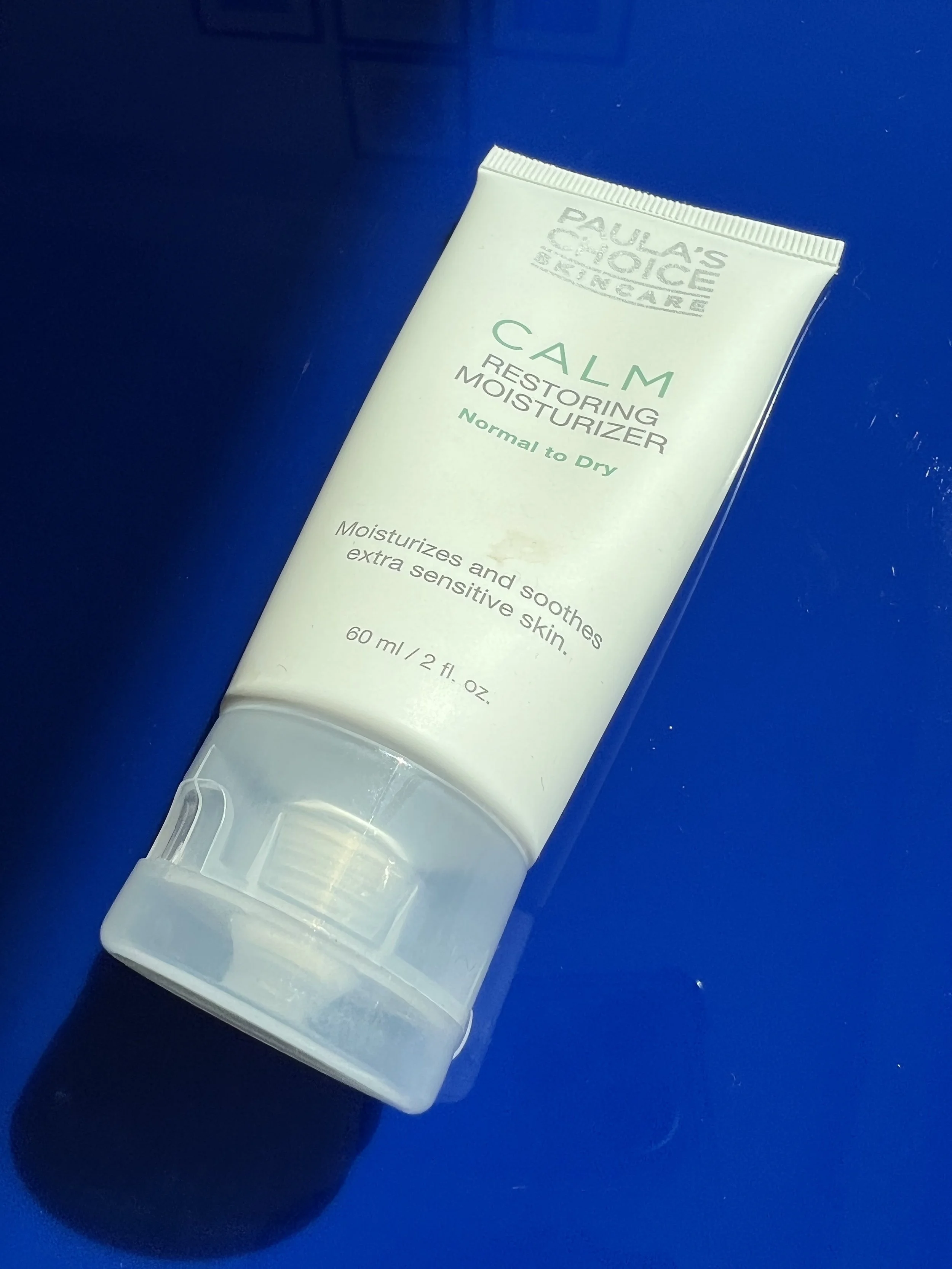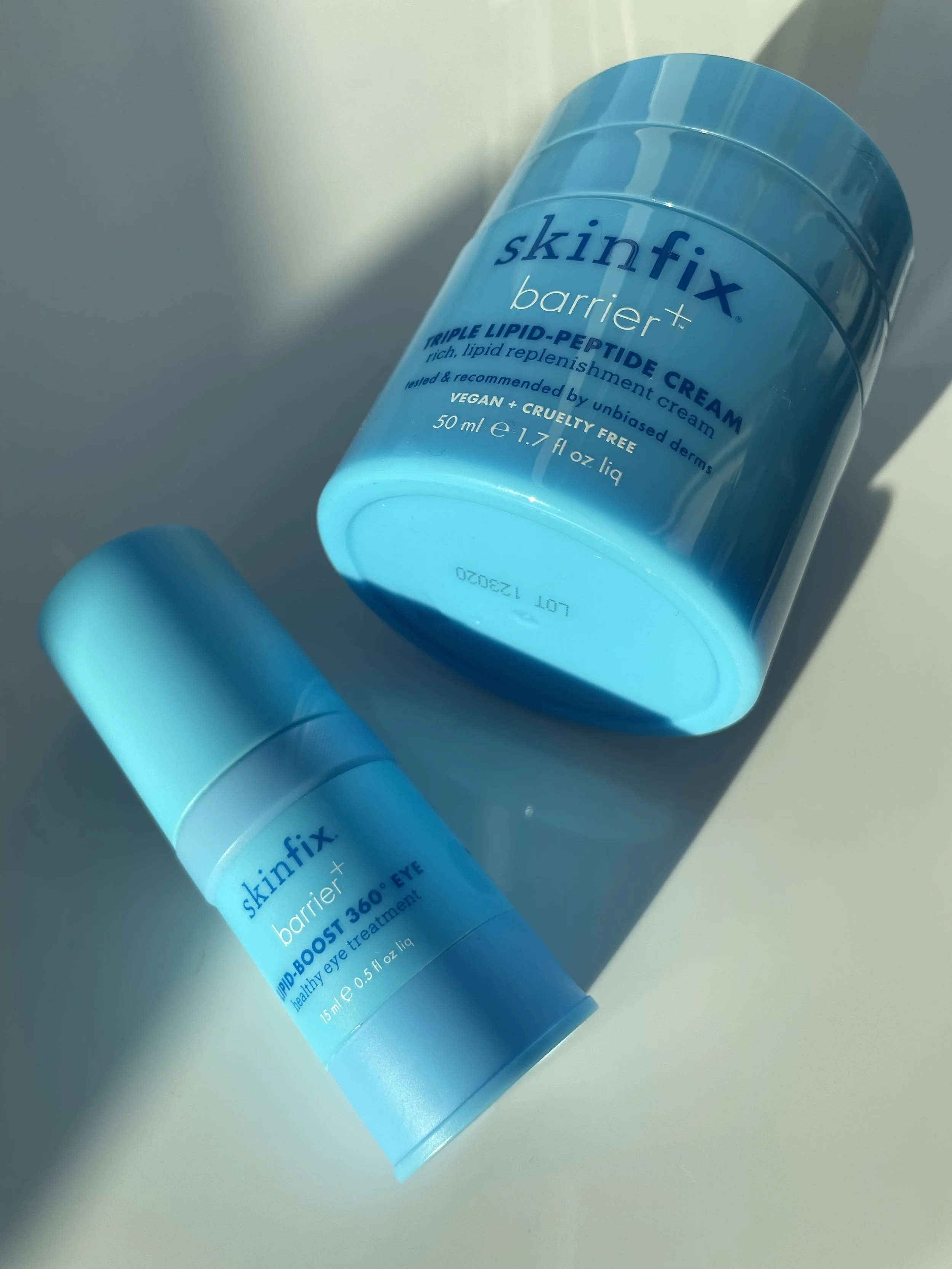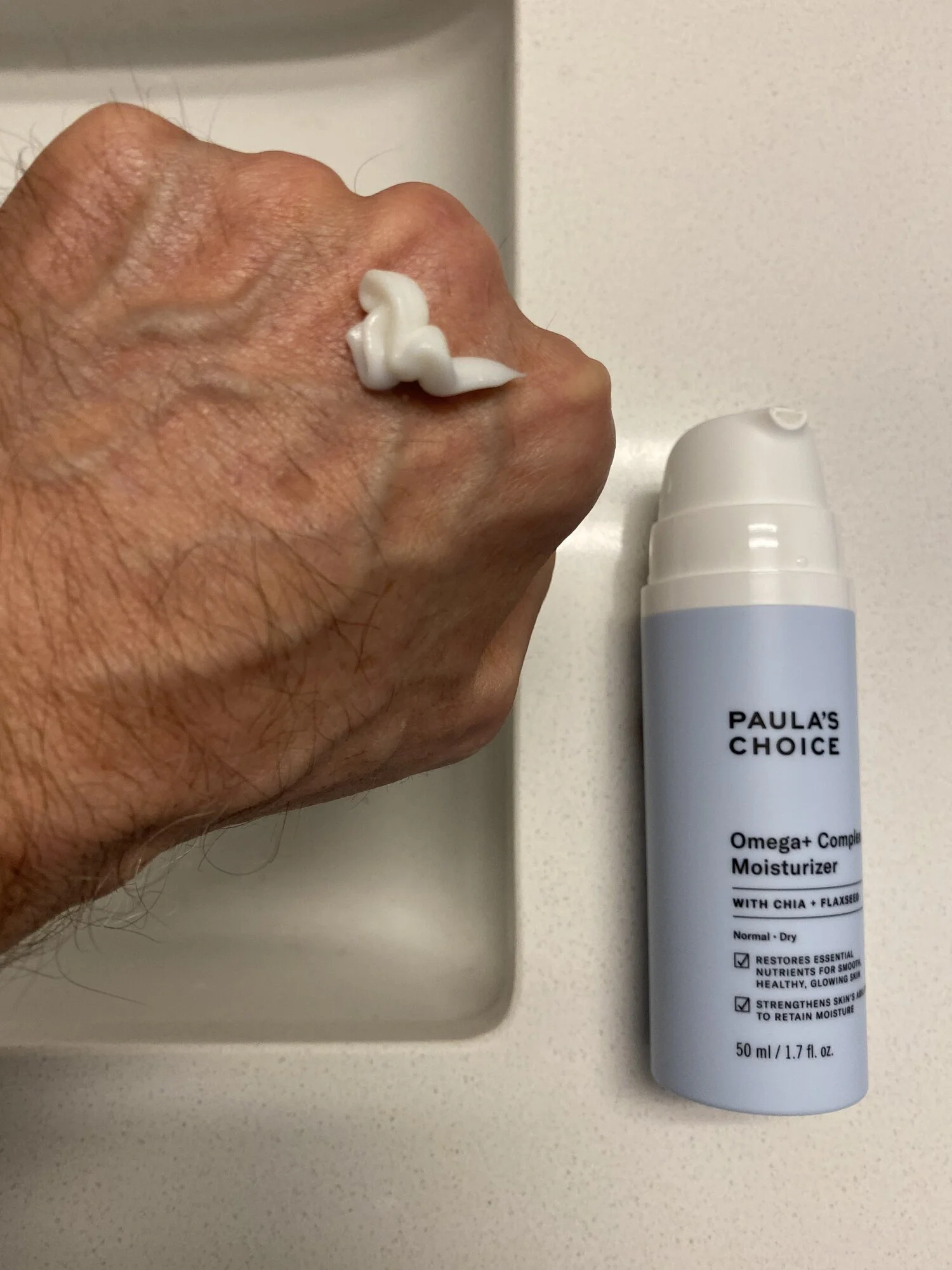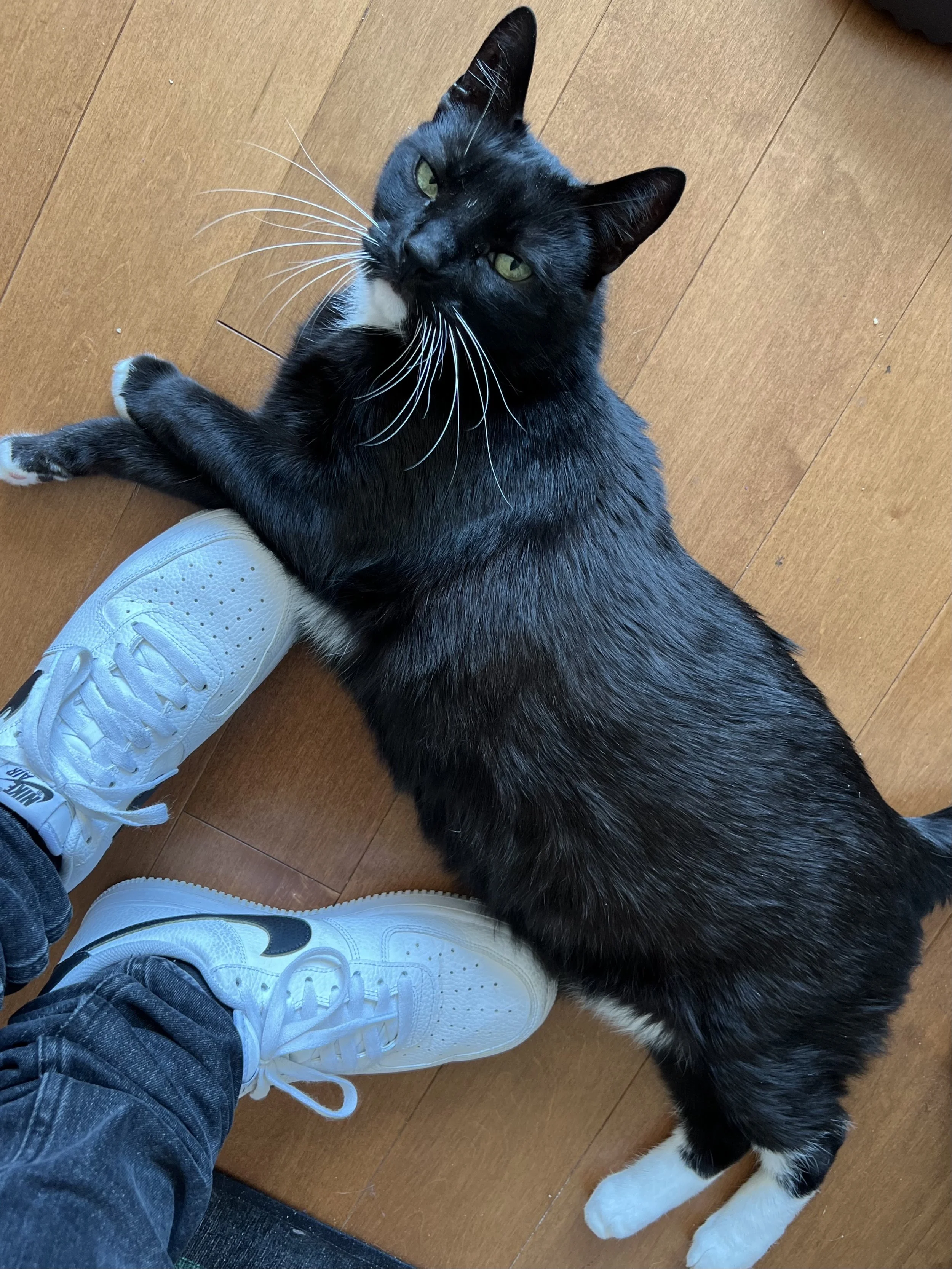PRODUCTS I'M INTO: PAULA’S CHOICE CALM COLLECTION - BEST SUNSCREEN FOR SENSITIVE SKIN, BEST FACE CREAM FOR REDNESS
I’m always seeking out gentle, effective skincare for sensitive skin. Not because I have sensitive skin necessarily, but because I know many people who believe they do.
It always makes me kinda sad when I recommend (or give!) a skincare product to someone and they say they’re afraid to use it because their skin reacts adversely to so many products that they avoid using anything new on their face. That sucks!
It’s hardly a way to maintain your skin health. And, sensitive skin isn’t healthy skin. It’s imbalanced skin. The solution isn’t to avoid skincare entirely. Rather, it’s to understand what’s throwing your skin out of whack and find a skincare routine comprised of products that work to calm and eliminate skin sensitivity.
So while I may not have sensitive skin per se, I get it. And I’ve been there. I test out so many products that it’s not uncommon for me to sensitize my skin. Glycolic Acid is often the culprit.
From time to time, my skin can become red, reactive and inflamed for a day or two. When it does, I put the brakes on anything harsh or overly aggressive. I remember one incident where even water aggravated my skin! As I recall, that time was retinol-induced.
SKINCARE HACKS: GLYCOLIC ACID IS THE NATURAL DEODORANT THAT WORKS!
I’ve made no secret of the fact that I have a love-hate relationship with Glycolic Acid, the most potent of the class of alpha hydroxy acids, and would really prefer to just use it in my underarms as a daily deodorant.
Glycolic Acid is such a popular and effective ingredient that I can’t avoid it. There are so many really well-formulated treatment toners with high concentrations of Glycolic Acid and I feel compelled to try them all! Even the 20% Glycolic Acid toners come across my desk — and my bathroom sink. So yeah, I can overdo it as easily as anyone.
I’ve also made no secret of the fact that I trust Paula’s Choice for all skin types, even sensitive skins. I have so many of the brand’s products in my regular daily skincare routines. Among them, of course, is the the Paula’s Choice 10% Niacinamide Booster — hand’s down the best anti-aging serum on Earth. I’ve spoken of it multiple times on the blog and even recently promoted it on my TikTok channel. Psst…you can catch it here!
PAULA’S CHOICE 10% NIACINAMIDE BOOSTER – BEST NIACINAMIDE SERUM FOR CLOGGED PORES
In addition to the 10% Niacinamide Booster, I’m also a big fan of the Paula’s Choice Skin Perfecting 2% BHA Liquid Exfoliant. I use the silky refining toner twice daily in conjunction with Paula’s Niacinamide serum to clear out my pores and keep my skin functioning optimally. In fact, I consider both products to be skin health essentials and rarely, if ever, go without them.
I’ve long had my eye on the Paula’s Choice Calm collection — formulated specifically for calming redness and irritation. Calm comprises a full range of skincare for sensitive skin — from cleansers to sunscreen and everything in between. I’ve just begun to explore it and am excited to share my initial thoughts.
Each Calm Redness Relief product is formulated with skin-replenishing plant oils, anti-aging actives and antioxidant-rich extracts “that research has shown to be among the most soothing for temperamental skin.”
My first foray into the Paula’s Choice Calm range includes the Paula’s Choice Redness Relief Toner, the brand’s Redness Relief Moisturizer for Normal to Dry Skin and the two sunscreen in the collection — one for normal to dry skin, the other for oily and combination skin.
It’s no surprise to me that I’ve found each of the products I’ve tried quite well-formulated, effective and pleasurable. The Paula’s Choice Redness Relief Toner is superbly hydrating and soothing and has become one of my favorite hydrating toners.
Additionally, the Redness Relief SPF 30 Mineral Moisturizer for Normal to Oily Skin is very likely one of the best mineral sunscreens for oily skin. It has one of the lightest textures for a mineral sunscreen that I’ve ever come across. I still can’t believe it’s a 100% mineral facial sunscreen. I suspect alien technology may be at play.
With that, let’s take a look at my favorite products from the Paula’s Choice Calm collection…
Paula’s Choice Redness Relief SPF 30 Mineral Moisturizer
I consider myself one of the biggest Paula’s Choice fans. So it’s funny to me that I can still discover products from Paula’s Choice I haven’t tried and that go on to blow me away. Especially a sunscreen!
For well-formulated daily sunscreens, there’s probably no brand except Supergoop! that I trust as much as Paula’s Choice.
So I’m hyped to (finally!) try the Redness Relief SPF 30 Mineral Moisturizer. There are actually two formulations: one for oily skin and one for dry skin. Both moisturizers with sunscreen are part of the Calm collection and formulated to “pamper sensitive, reddened skin” with “a redness-minimizing mix of soothing plant extracts, antioxidants, and peptides work to calm sensitive skin.”
The Best Sunscreens For Face
How Much UV Is Blocked by Sunscreen and What Percent of UV Rays Are Blocked by Sunscreen?
SPF 15 blocks 93% of UVB rays
SPF 20 blocks 95% of UVB rays
SPF 30 blocks 97% of UVB rays
SPF 50 blocks 98% of UVB rays.
So, the difference between SPF 30 and SPF 50 is about 1 percent.
As I’ve said, I don’t have sensitive skin; rather, I can experience sensitized skin on occasion — admittedly self-inflicted. The Redness Relief SPF 30 Mineral Moisturizer seems ideal for anyone in either camp. And as such, the product is great for all skin types, whether your skin is combination, oily, dry or, like me, normal on most days.
Each of the Redness Relief SPF 30 Mineral Moisturizers is made with two common mineral sun filters: Titanium Dioxide and Zinc Oxide.
What’s uncommon about Redness Relief is the formula’s cocktail of skin-soothing actives: Allantoin, Chamomile Flower Extract, Green Tea Leaf Extract, Licorice Root Extract, and Aloe Leaf Juice. All are tried-and-true ingredients for calming irritation. Combining them isn’t a breakthrough, but it’s ideal for very sensitive skin.
What’s the Difference between Mineral and Chemical Sunscreens?
While I prefer mineral sunscreens, I truly believe what’s most important is to find a sunscreen you like to use so much that you wouldn’t think of skipping it — even on cloudy, seemingly sunless days. If that’s a chemical sunscreen, perfect. One of my favorite sunscreens of all time is a chemical sunscreen. The Supergoop! Daily Dose Vitamin C + SPF 40 Sunscreen Serum PA+++ is so welll-formulated and such a pleasure to use that I get excited to apply it. You can catch my review of it here.
But I know chemical sun filters can be controversial. For insights on the two types of sun filters, chemical and mineral (pr physical), there’s an excellent article by the Paula’s Choice Research Team titled, Mineral vs. Synthetic Sunscreen Ingredients available here. In the piece, the experts explain the differences and benefits between mineral and chemical sunscreens — and even dispel a myth or two:
“The two types of sunscreen ingredients are mineral and synthetic [chemical], and both are equally protective. Further reassuring is that each can be included in formulas created for every skin type. For example, if you have normal to oily skin, there are weightless, non-greasy options; if you have normal to dry skin, it’s possible to find skin-smoothing, hydrating SPF products.
What’s the Difference Between Mineral and Synthetic Sunscreen Ingredients?
The differences aren’t about which type is more effective; rather, it comes down to personal preference and how sensitive your skin is—mineral sunscreens are considered the most gentle options.
Mineral sunscreens: There are only two mineral sunscreen ingredients: titanium dioxideand zinc oxide. They work in skin's uppermost layers to both absorb and, to a lesser extent, deflect and scatter the sun’s harmful rays. These mineral ingredients are sometimes referred to as physical sunscreens or physical blockers, although that’s not a factual representation of how they work.
Synthetic sunscreens: There are over 30 synthetic sunscreen ingredients, all of which absorb into the top layers of skin, where they work similar to mineral sunscreens: by scattering and deflecting the sun’s harmful rays, and by converting UV rays into heat and “deactivating” them. (Don’t worry, you won’t feel a thing.) Common synthetic sunscreen ingredients include oxybenzone, octinoxate, octisalate, and avobenzone. These are sometimes labeled “chemical sunscreens,” which is both misleading and false. All skin care ingredients, even water, are chemicals.
The oily skin version, the Redness Relief SPF 30 Mineral Moisturizer for Normal to Oily Skin, is heavy on hydrators, light on oils, and with a wonderfully lightweight, silky texture.
On the other hand, the Redness Relief SPF 30 Mineral Moisturizer for Normal to Dry Skin, the dry skin variation, is a bit heavier, contains the same skin-soothing cocktail and multiple replenishing plant oils, including Apricot Kernel Oil at ingredient number four. It’s rich, but not too rich.
If you have a concern for sensitive (or sensitized!) skin, the two Paula’s Choice Calm Redness Relief SPF 30 Mineral Moisturizers were made for you!
What I like about it: The Redness Relief SPF 30 Mineral Moisturizer for Normal to Oily Skin is one of the best sunscreens for oily skin that I’ve come across. With such a lightweight, blendable texture, it’s crazy to me that it’s a mineral sunscreen. And, I’m impressed with its potent blend of skin-soothing actives for calming sensitivity. If you have oily skin, blemish prone skin or sensitive skin, this is your sunscreen. If you have dry, sensitive skin, the Redness Relief SPF 30 Mineral Moisturizer for Normal to Dry Skin is the perfect option.
What I don’t like about it: Honestly, both formulas are near-perfect sunscreens. (I leave perfection to Mother Nature!) The only improvement I can imagine is to bump up the sun protection to an SPF 50. I’m kind of surprised it’s not already there. But, as I shared earlier, the difference in the level of UV rays blocked by SPF 30 and SPF 50 is about one percent. That’s negligible.
Who it’s for: All skin types, especially sensitive skins.
SHOP THE BLOG: Purchase the Paula’s Choice Redness Relief SPF 30 Mineral Moisturizer for Normal to Oily Skin for $31 here. (Or select the dry skin version here.)
Paula’s Choice Redness Relief Redness Relief Toner for Normal to Dry Skin
I love talking about toners with people. It all usually goes over their heads because we — and by that I mean we Americans — have been conditioned to believe that toners aren’t a necessary skincare step. If your skincare routine is too complicated or too expensive, just skip the toner. That’s such a mistake. Why? Because toners hydrate the skin more effectively than just about any other skincare product. And hydrated skin is healthy skin.
The whole concept of a toner has been complicated by skincare marketers who push what are now referred to as “treatment toners.” They’re formulated with exfoliating acids like Glycolic Acid and intended to resurface the skin and instantly brighten the complexion. And they shouldn’t be (but are!) confused with classic hydrating toners — the ones that should be the next step in every serious pro-skin health regimen after cleansing.
One of my favorite hydrating toners also happens to be one of the best toners for sensitive skin — the First Aid Beauty Ultra Repair Wild Oat Hydrating Toner. With its velvety texture and skin-soothing properties, FAB’s Ultra Repair Wild Oat Hydrating Toner is an excellent option for both dry and sensitive skin types. Catch my review of it on the blog here.
PRODUCT REVIEW: FIRST AID BEAUTY ULTRA REPAIR WILD OAT HYDRATING TONER – BEST TONER FOR SENSITIVE SKIN
With my experience of the First Aid Beauty Ultra Repair Wild Oat Hydrating Toner in mind, I’ve been using the Paula’s Choice Redness Relief Toner for several weeks. I have to admit, it’s equally pleasurable and pro-skin health.
While I love its hydrating properties, what stands out most to me about the Redness Relief Toner formula is its powerful complex of soothing botanical extracts that combine for a high concentration of skin soothers to calm irritated skin. Among these, and all in the top ten of the INCI, are Allantoin, Genistein, Carnosine, Dipotassium Glycyrrhizate, and Epigallocatechin Gallate (EGCG) — a component extracted from green tea with powerful antioxidant and soothing properties.
In fact, I’d go so far as to say that the Redness Relief Toner is the most skin-soothing of the entire Calm collection. All the more reason not to skip the toner!
The Paula’s Choice Redness Relief Toner has a slightly pulpy, milky texture, though it’s not at all heavy on the skin. It absorbs as quickly as a lighter, more watery toner.
In additon to its cocktail of soothing actives, there are a handful of humectants, brightening botanicals and even, curiously, phospholipids. It seems so random in a toner, but I love the inclusion of these bio-compatible fats.
According to the Paula’s Choice Research Team, phospholipids are among the best ingredients used in skincare. They’re defined this way:
Phospholipids are types of lipids (fats) composed of glycerol, fatty acids, and phosphate (a salt made from the non-metallic element phosphorus). They occur naturally within the human body and can be derived from plant and animal sources, such as soybeans, egg yolks, and milk. Phospholipids can also be synthetically derived. Lecithin is an example of a phospholipid.
Phospholipids in skin care have value for numerous reasons– chief among them is that they are hygroscopic, meaning they pull in water from surrounding air and hold it where more hydration is needed. That means they have excellent moisturizing capabilities without being occlusive. Applying phospholipids to skin can help replace phospholipids that are depleted either through cleansing or from environmental factors. Research also shows that phospholipids can have antioxidant properties and be effective in helping deliver other ingredients more effective to skin in cosmetics. As skin-natural ingredients, phospholipids are considered safe as used in skin care in concentrations up to 50%; however, they are most often used as part of a blend with glycerin, lecithin (itself a source of phospholipids as stated above) and ceramides.
The Paula’s Choice Redness Relief Toner is an excellent option for all skin types, but especially sensitive and sensitized skin. Adding just one product like a well-formulated hydrating facial toner to your daily skincare routine can really up your game — and your skin health.
What I like about it: The Paula’s Choice Redness Relief Toner is among the best hydrating toners I’ve come across. I really love its powerful cocktail of skin-soothing actives that make it ideal for both sensitive and sensitized skin. In fact, I’d go so far as to say that the Redness Relief Toner is the best product in the brand’s Calm collection.
What I don’t like about it: I like everything about this hydrating toner.
Who it’s for: All skin types, but especially sensitive and sensitized skin.
SHOP THE BLOG: Purchase the Paula’s Choice Redness Relief Toner for Normal to Dry Skin for $22 here.
Paula’s Choice Redness Relief Moisturizer for Normal to Dry Skin
Similar to the approach taken with the two mineral SPF sunscreens, the Paula’s Choice Calm range offers two separate face creams — a richer one for normal to dry skin, and a lighter one for oily and combination skin.
Admittedly, I have not had the opportunity yet to test the Redness Relief Moisturizer for Normal to Oily Skin. However, I have been using the Redness Relief Moisturizer for Normal to Dry Skin for several weeks now and really like the formula.
The brand’s Redness Relief Moisturizer for dryer skin types is richer than I was expecting it to be. In fact, it’s one of those face creams that barely works in a tube. It’s that thick. It’s even thicker than my favorite moisturizer for dry skin and all skin types in the cold, the Skinfix Barrier+ Triple Lipid-Peptide Face Cream.
PRODUCT REVIEW: SKINFIX BARRIER+ TRIPLE LIPID-PEPTIDE CREAM – BEST FACE CREAM FOR DRY SKIN
So while I like the Redness Relief Moisturizer formula a lot, there’s a high bar when it comes to evaluating a face cream for dry skin. And I’m the ideal test case in a low-humidity climate like New York City in February and March.
Over the last several weeks, the weather here has vacillated between wintry cold and warmer days that feel like a glimpse of summer. So I’ve had the unique opportunity to try out the Redness Relief Moisturizer on both warm and cold nights.
With its high concentration of replenishing plant oils as well as emollient lipids like ceramides and cholesterol, the product has certainly been an effective moisturizer on the coldest of nights. Again, it’s rich; but interestingly, it absorbs nicely into skin, leaving a comfortable, occlusive film over the skin to help prevent trans-epidermal water loss — the leading cause of skin dehydration and one of the causes of skin aging.
Maintaining sufficient hydration levels year-round is essential for skin to function at its peak. Healthy functioning skin is simply better able to defend against external aggressors like pollution, UV, and free radical attacks. And healthy skin is better fortified against signs of aging like lines, wrinkles and sagging.
What Is Trans-Epidermal Water Loss and What Causes Trans Epidermal Water Loss?
For a deep dive into trans-epidermal water loss, or TEWL, there’s an excellent article on the health website Skin Better titled, What Is Transepidermal Water Loss and Why Is it Important? It’s available to read here.
In the piece, the author explains TEWL as follows:
“The skin is comprised of three primary layers: the epidermis, the outermost layer; the dermis or middle layer; and the hypodermis, the undermost layer. When water passes from the dermis through the epidermis and evaporates from the skin’s surface, this is known as transepidermal water loss (International Journal of Pharmaceutics).
While TEWL is a process that your skin naturally regulates, certain factors that can damage the skin’s barrier function can also affect TEWL levels. Circumstances such as injury, low-humidity weather conditions and topically applied products that dry out the skin can impact TEWL.
To achieve this, combine humectant and occlusive skincare ingredients.
Transepidermal water loss can contribute to a variety of dry skin conditions, and although it is a natural process, there are ways that you can help your skin stay moisturized and hydrated. Hydration refers to the water content of the skin, whereas moisturization is the skin’s ability to retain those water molecules. Therefore, your skin needs both elements to maintain desirable levels of TEWL.
To achieve this, combine humectant and occlusive skincare ingredients. Humectants help to draw moisture to the epidermis, either from the air if it is humid enough, or from the underlying dermis in low-humidity conditions. Because water content that is drawn from the dermis can be lost through TEWL, it’s important to combine the use of humectants with occlusives. Together, these ingredients create a reservoir of moisture in the epidermis and act as a barrier on the skin to help prevent TEWL by sealing in that moisture. The occlusive agents simultaneously keep pollutants, toxins and harmful bacteria out (Skin Therapy Letter).”
The Best Face Creams For Dry Skin
In addition to the Redness Relief Moisturizer’s blend of emollient plant oils like Jojoba Seed Oil and Squalane, which do have soothing properties for the skin, there’s perhaps a 3-4% concentration of Allantoin — a common, yet relatively effective soothing extract that’s considered by the experts on the Paula’s Choice Research Team to be among the best ingredients used in skincare.
What is Allantoin and why is it among the best skincare ingredients for soothing irritated skin? The Paula’s Choice Research Team defines it this way:
Allantoin is a byproduct of uric acid that can be extracted from urea and is the result of metabolic processes that occur in most organisms - among them animals (including humans) and bacteria. It can also be extracted from comfrey (taken from the roots and leaves) and is proven safe and effective because it does not contain the potentially irritating alkaloid compounds that occur in the comfrey plant.
It serves as an effective soothing agent and has moisturizing properties, giving it value especially in products designed to treat sensitive or compromised skin. It can also help mitigate skin’s response to stronger active ingredients and is often included in formulas to help buffer any potential adverse effects.
In cosmetics, it is used in concentrations up to 2%, but in clinical settings it can be used in greater amounts, where research has shown it can have an impact on healing. In the United States, it is FDA-approved as an over the counter (OTC) skin protectant in concentrations of 0.5-2%.
The Paula’s Choice Redness Relief Moisturizer is effective for sensitive and irritated skin as much for what’s in the formula as what isn’t. If you struggle with sensitivity or sensitization, the last thing you want to be using is a face cream with fragrance in the form of essential oils, fragrant components, or drying alcohols. Of course, in classic Paula’s Choice fashion, the Redness Relief Moisturizer is free of these known skin sensitizers.
While the formula does contain both antioxidant Vitamin E and Vitamin C (in the form of Magnesium Ascorbyl Phosphate), I do wish it contained higher concentrations of antioxidant botanical extracts to help protect skin against free radical damage. It’s not entirely devoid of antioxidants, but its lack of soothing botanicals like Green Tea Extract, Centella Asiatica and even Bisabolol (the active component of chamomile) is surprising given the brand’s firm emphasis on antioxidant protection.
Honestly, while I do like the Paula’s Choice Redness Relief Moisturizer, it can’t compare to my favorite face cream from the brand, the Paula’s Choice Omega+ Complex Moisturizer. That baby is gold for dry and even sensitive skin.
Catch my review of the Omega+ Complex Moisturizer on the blog here.
PRODUCT REVIEW: PAULA’S CHOICE OMEGA+ COMPLEX MOISTURIZER - BEST FACE CREAM FOR DRY SKIN
What I like about it: Rich in replenishing emollients, the Paula’s Choice Redness Relief Moisturizer for Normal to Dry Skin is an effective face cream for dry, dehydrated skin. I love its occlusive effect that helps to prevent trans-epidermal water loss and the fact that it quickly absorbs into the skin surface, despite its rich texture.
What I don’t like about it: I do wish it contained even more antioxidant oomph in the form of soothing botanicals like Green Tea Extract, Centella Asiatica and Bisabolol for enhanced protection against environmental aging. That feels like a rare miss from Paula’s Choice.
Who it’s for: Normal and dry skin — but especially dry, sensitive skin types.
SHOP THE BLOG: Purchase the Paula’s Choice Redness Relief Moisturizer for Normal to Dry Skin for $31 here. (Check out the oily skin version here.)
Thanks for checking in on the Skincarma Blog! I hope this helps you discover what I consider some of the best facial skincare for sensitive skin and redness.
See you next week!
💟 Carmine @skincarma
WATCH MY VIDEO REVIEW
MY SUMMER EMPTIES : SUNSCREENS, VITAMIN C SERUMS & MORE FACIAL SKIN CARE!
ON MY YOUTUBE CHANNEL HERE
WATCH MY VIDEO REVIEW OF
COOL CLEAN FACIAL SUNSCREENS TO KEEP US SAFE AND SMILING IN THE SUN
ON MY YOUTUBE CHANNEL HERE
WATCH MY VIDEO REVIEW
THE YEAR’S BEST VITAMIN C SERUMS WITH THE ORDINARY, CLINIQUE, BEAUTY STAT & MORE!
ON MY YOUTUBE CHANNEL HERE
WATCH MY VIDEO REVIEW
THE YEAR’S BEST VITAMIN C SERUMS WITH PAULA'S CHOICE, SUNDAY RILEY, THE INKEY LIST AND MORE!
ON MY YOUTUBE CHANNEL HERE
WATCH MY VIDEO REVIEW OF
SKINCARE HACKS: GLYCOLIC ACID IS THE NATURAL DEODORANT THAT WORKS!
ON MY YOUTUBE CHANNEL HERE
The Ingredient List of the Paula’s Choice Redness Relief SPF 30 Mineral Moisturizer for Normal to Oily Skin:
 so 0 0, Chamomilla Recutita Matricaria Flower Extract (Skin-Soothing)
so 0 0, Chamomilla Recutita Matricaria Flower Extract (Skin-Soothing)  so|aox 0 0, Camellia Sinensis Leaf Extract (Green Tea Extract/Skin-Soothing)
so|aox 0 0, Camellia Sinensis Leaf Extract (Green Tea Extract/Skin-Soothing)  aox|so, Glycyrrhiza Glabra Root Extract (Licorice Extract/Skin-Soothing)
aox|so, Glycyrrhiza Glabra Root Extract (Licorice Extract/Skin-Soothing)  so|sb, Alumina (Stabilizer) vc|abrasive/scrub, Aloe Barbadensis Leaf Juice (Hydration/Skin-Soothing)
so|sb, Alumina (Stabilizer) vc|abrasive/scrub, Aloe Barbadensis Leaf Juice (Hydration/Skin-Soothing)  so|h, Glycerin (Hydration)
so|h, Glycerin (Hydration)  sii|h 0 0, Panthenol (Skin Replenishing)
sii|h 0 0, Panthenol (Skin Replenishing)  so|h 0 0, Algae Extract (Skin Replenishing)
so|h 0 0, Algae Extract (Skin Replenishing)  emo|h, Lauryl PEG-9 Polydimethylsiloxyethyl Dimethicone emu|surf, Polyhydroxystearic Acid (Texture-Enhancing) emu, Triethoxysilylethyl Polydimethylsiloxyethyl Hexyl Dimethicone (Texture-Enhancing), Caprylyl Glycol (Preservative) h|emo, Butylene Glycol (Hydration) h|solv|vc 0 1, Diethylhexyl Carbonate (Stabilizer) emo, Triethoxycaprylylsilane (Texture-Enhancing), Disodium EDTA (Stabilizer) chel, Phenoxyethanol (Preservative) pres, Chlorphenesin (Preservative) pres|amic
emo|h, Lauryl PEG-9 Polydimethylsiloxyethyl Dimethicone emu|surf, Polyhydroxystearic Acid (Texture-Enhancing) emu, Triethoxysilylethyl Polydimethylsiloxyethyl Hexyl Dimethicone (Texture-Enhancing), Caprylyl Glycol (Preservative) h|emo, Butylene Glycol (Hydration) h|solv|vc 0 1, Diethylhexyl Carbonate (Stabilizer) emo, Triethoxycaprylylsilane (Texture-Enhancing), Disodium EDTA (Stabilizer) chel, Phenoxyethanol (Preservative) pres, Chlorphenesin (Preservative) pres|amicThe Ingredient List of the Paula’s Choice Redness Relief SPF 30 Mineral Moisturizer for Normal to Dry Skin:
 emo 0 1-2, Cyclopentasiloxane (Hydration) emo|solv, Glyceryl Stearate (Emollient) emo|emu 0 1-2, PEG-100 Stearate (Texture-Enhancing) surf|emu 0 0, Butylene Glycol (Hydration) h|solv|vc 0 1, Pentylene Glycol (Hydration) solv|h, Cetearyl Alcohol (Emollient) emo|vc|emu|surf 1 2, Dimethicone (Hydration) emo 0 1, Glycine Soja Sterols (Soybean/Emollient) emo, Vp/Eicosene Copolymer (Texture-Enhancing) vc, Avena Sativa Kernel Extract (Oat Extract/Skin-Soothing)
emo 0 1-2, Cyclopentasiloxane (Hydration) emo|solv, Glyceryl Stearate (Emollient) emo|emu 0 1-2, PEG-100 Stearate (Texture-Enhancing) surf|emu 0 0, Butylene Glycol (Hydration) h|solv|vc 0 1, Pentylene Glycol (Hydration) solv|h, Cetearyl Alcohol (Emollient) emo|vc|emu|surf 1 2, Dimethicone (Hydration) emo 0 1, Glycine Soja Sterols (Soybean/Emollient) emo, Vp/Eicosene Copolymer (Texture-Enhancing) vc, Avena Sativa Kernel Extract (Oat Extract/Skin-Soothing)  aox|so|emo|abrasive/scrub, Glycerin (Hydration/Skin Replenishing)
aox|so|emo|abrasive/scrub, Glycerin (Hydration/Skin Replenishing)  sii|h 0 0, Sodium Hyaluronate (Hydration)
sii|h 0 0, Sodium Hyaluronate (Hydration)  sii|h 0 0, Allantoin (Skin-Soothing)
sii|h 0 0, Allantoin (Skin-Soothing)  so 0 0, Tocopheryl Acetate (Vitamin E/Antioxidant) aox 0 0, Hydrogenated Lecithin (Skin Replenishing)
so 0 0, Tocopheryl Acetate (Vitamin E/Antioxidant) aox 0 0, Hydrogenated Lecithin (Skin Replenishing)  emo|emu, Tetrahexyldecyl Ascorbate (Vitamin C/Antioxidant)
emo|emu, Tetrahexyldecyl Ascorbate (Vitamin C/Antioxidant)  aox|sb, Superoxide Dismutase (Antioxidant)
aox|sb, Superoxide Dismutase (Antioxidant)  aox, Ubiquinone (Antioxidant)
aox, Ubiquinone (Antioxidant)  aox, Ceramide NG (Hydration/Skin Replenishing)
aox, Ceramide NG (Hydration/Skin Replenishing)  sii, Methicone (Hydration) emo, Palmitoyl Hexapeptide-12 (Texture-Enhancing)
sii, Methicone (Hydration) emo, Palmitoyl Hexapeptide-12 (Texture-Enhancing)  cci, PEG-10 Dimethicone (Texture-Enhancing) emu, Cucumis Sativus Fruit Extract (Cucumber Extract/Skin-Soothing)
cci, PEG-10 Dimethicone (Texture-Enhancing) emu, Cucumis Sativus Fruit Extract (Cucumber Extract/Skin-Soothing)  so|emo, Caprylic/Capric Triglyceride (Emollient) emo, Tribehenin (Emollient) emo, PEG-10 Phytosterol (Texture-Enhancing/Emollient) emu, Sorbitan Stearate (Texture-Enhancing) emu 1 0, Polyhydroxystearic Acid (Texture-Enhancing) emu, Alumina (Stabilizer) vc|abrasive/scrub, Polysorbate 20 (Stabilizer) emu|surf 0 0, Aluminum Stearate (Texture-Enhancing) col|vc, Xanthan Gum (Texture-Enhancing) vc, Caprylyl Glycol (Preservative) h|emo, Disodium EDTA (Stabilizer) chel, Ethylhexylglycerin (Preservative) pres, Phenoxyethanol (Preservative) pres, Chlorphenesin (Preservative) pres|amic
so|emo, Caprylic/Capric Triglyceride (Emollient) emo, Tribehenin (Emollient) emo, PEG-10 Phytosterol (Texture-Enhancing/Emollient) emu, Sorbitan Stearate (Texture-Enhancing) emu 1 0, Polyhydroxystearic Acid (Texture-Enhancing) emu, Alumina (Stabilizer) vc|abrasive/scrub, Polysorbate 20 (Stabilizer) emu|surf 0 0, Aluminum Stearate (Texture-Enhancing) col|vc, Xanthan Gum (Texture-Enhancing) vc, Caprylyl Glycol (Preservative) h|emo, Disodium EDTA (Stabilizer) chel, Ethylhexylglycerin (Preservative) pres, Phenoxyethanol (Preservative) pres, Chlorphenesin (Preservative) pres|amicThe Ingredient List of the Paula’s Choice Redness Relief Redness Relief Toner for Normal to Dry Skin:
 sii|h 0 0, Cyclopentasiloxane emo|solv, Glycereth-26 h|emo|vc 0 0, Allantoin
sii|h 0 0, Cyclopentasiloxane emo|solv, Glycereth-26 h|emo|vc 0 0, Allantoin  so 0 0, Genistein
so 0 0, Genistein  aox, Carnosine
aox, Carnosine  aox|cci, Dipotassium Glycyrrhizate
aox|cci, Dipotassium Glycyrrhizate  so|h, Epigallocatechin Gallate
so|h, Epigallocatechin Gallate  aox|so, Glycyrrhiza Glabra Root Extract
aox|so, Glycyrrhiza Glabra Root Extract  so|sb, Boerhavia Diffusa Root Extract, Caprylic/Capric Triglyceride emo, Dimethiconol emo|h, Sodium Hyaluronate
so|sb, Boerhavia Diffusa Root Extract, Caprylic/Capric Triglyceride emo, Dimethiconol emo|h, Sodium Hyaluronate  sii|h 0 0, Oleic Acid emo|emu, Linolenic Acid
sii|h 0 0, Oleic Acid emo|emu, Linolenic Acid  sii|emo|surf|perf, Palmitic Acid sii|emo|emu 0 2, Linoleic Acid
sii|emo|surf|perf, Palmitic Acid sii|emo|emu 0 2, Linoleic Acid  sii|emo|surf, Phospholipids
sii|emo|surf, Phospholipids  sii|emo, Epilobium Angustifolium Flower/Leaf/Stem Extract, Polysorbate 20 emu|surf 0 0, Hydrogenated Lecithin
sii|emo, Epilobium Angustifolium Flower/Leaf/Stem Extract, Polysorbate 20 emu|surf 0 0, Hydrogenated Lecithin  emo|emu, Acrylates/C10-30 Alkyl Acrylate Crosspolymer vc, Xanthan Gum vc, Laureth-4 emu|surf 4 5, Laureth-23 emu|surf 0 3, Sodium Hydroxide buff, Butylene Glycol h|solv|vc 0 1, Disodium EDTA chel, Ethylhexylglycerin pres, Phenoxyethanol pres
emo|emu, Acrylates/C10-30 Alkyl Acrylate Crosspolymer vc, Xanthan Gum vc, Laureth-4 emu|surf 4 5, Laureth-23 emu|surf 0 3, Sodium Hydroxide buff, Butylene Glycol h|solv|vc 0 1, Disodium EDTA chel, Ethylhexylglycerin pres, Phenoxyethanol presThe Ingredient List of the Paula’s Choice Redness Relief Moisturizer for Normal to Dry Skin:
 emo 0 0-2, Butylene Glycol h|solv|vc 0 1, Glycerin
emo 0 0-2, Butylene Glycol h|solv|vc 0 1, Glycerin  sii|h 0 0, Petrolatum emo, Cetearyl Alcohol emo|vc|emu|surf 1 2, Dipentaerythrityl Hexacaprylate/Hexacaprate emo|emu|vc, Tridecyl Trimellitate emo, Phenyl Trimethicone emo, Sodium Hyaluronate
sii|h 0 0, Petrolatum emo, Cetearyl Alcohol emo|vc|emu|surf 1 2, Dipentaerythrityl Hexacaprylate/Hexacaprate emo|emu|vc, Tridecyl Trimellitate emo, Phenyl Trimethicone emo, Sodium Hyaluronate  sii|h 0 0, Ceramide NP
sii|h 0 0, Ceramide NP  sii, Cholesterol
sii, Cholesterol  sii|emo 0 0, Tocopherol
sii|emo 0 0, Tocopherol  aox 0-3 0-3, Squalane
aox 0-3 0-3, Squalane  sii|emo 0 1, Magnesium Ascorbyl Phosphate
sii|emo 0 1, Magnesium Ascorbyl Phosphate  sb|aox, Dimethicone emo 0 1, Polysorbate 60 emu|surf, Hydrolyzed Jojoba Protein, Hydrolyzed Wheat Protein
sb|aox, Dimethicone emo 0 1, Polysorbate 60 emu|surf, Hydrolyzed Jojoba Protein, Hydrolyzed Wheat Protein  h, Avena Sativa Kernel Extract
h, Avena Sativa Kernel Extract  aox|so|emo|abrasive/scrub, Hydrogenated Lecithin
aox|so|emo|abrasive/scrub, Hydrogenated Lecithin  emo|emu, Whey Protein
emo|emu, Whey Protein  cci, Tridecyl Stearate emo, Neopentyl Glycol Dicaprylate/Dicaprate emo, Myristyl Myristate emo 2 0-5, Linoleic Acid
cci, Tridecyl Stearate emo, Neopentyl Glycol Dicaprylate/Dicaprate emo, Myristyl Myristate emo 2 0-5, Linoleic Acid  sii|emo|surf, Linolenic Acid
sii|emo|surf, Linolenic Acid  sii|emo|surf|perf, Decarboxy Carnosine Hcl, Hydroxyethyl Acrylate/Sodium Acryloyldimethyl Taurate Copolymer vc, Acrylates/C10-30 Alkyl Acrylate Crosspolymer vc, Cetearyl Glucoside emu|surf, Cetyl Alcohol emo|vc 2 2, Polyglyceryl-3 Beeswax emu, Aminomethyl Propanol buff, Disodium EDTA chel, Phenoxyethanol pres, Benzoic Acid pres, Chlorphenesin pres|amic, Sorbic Acid pres
sii|emo|surf|perf, Decarboxy Carnosine Hcl, Hydroxyethyl Acrylate/Sodium Acryloyldimethyl Taurate Copolymer vc, Acrylates/C10-30 Alkyl Acrylate Crosspolymer vc, Cetearyl Glucoside emu|surf, Cetyl Alcohol emo|vc 2 2, Polyglyceryl-3 Beeswax emu, Aminomethyl Propanol buff, Disodium EDTA chel, Phenoxyethanol pres, Benzoic Acid pres, Chlorphenesin pres|amic, Sorbic Acid pres



